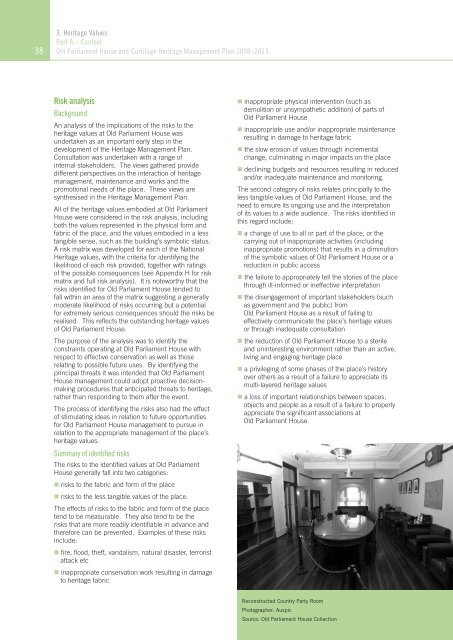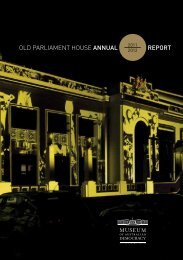OLD PARLIAMENT HOUSE AND CURTILAGE HERITAGE MANAGEMENT PLAN 2008–2013
Heritage Management Plan 2008-2013 - Museum of Australian ...
Heritage Management Plan 2008-2013 - Museum of Australian ...
- No tags were found...
Create successful ePaper yourself
Turn your PDF publications into a flip-book with our unique Google optimized e-Paper software.
3. Heritage Values<br />
Part A – Context<br />
38 Old Parliament House and Curtilage Heritage Management Plan <strong>2008–2013</strong><br />
Risk analysis<br />
Background<br />
An analysis of the implications of the risks to the<br />
heritage values at Old Parliament House was<br />
undertaken as an important early step in the<br />
development of the Heritage Management Plan.<br />
Consultation was undertaken with a range of<br />
internal stakeholders. The views gathered provide<br />
different perspectives on the interaction of heritage<br />
management, maintenance and works and the<br />
promotional needs of the place. These views are<br />
synthesised in the Heritage Management Plan.<br />
All of the heritage values embodied at Old Parliament<br />
House were considered in the risk analysis, including<br />
both the values represented in the physical form and<br />
fabric of the place, and the values embodied in a less<br />
tangible sense, such as the building’s symbolic status.<br />
A risk matrix was developed for each of the National<br />
Heritage values, with the criteria for identifying the<br />
likelihood of each risk provided, together with ratings<br />
of the possible consequences (see Appendix H for risk<br />
matrix and full risk analysis). It is noteworthy that the<br />
risks identified for Old Parliament House tended to<br />
fall within an area of the matrix suggesting a generally<br />
moderate likelihood of risks occurring but a potential<br />
for extremely serious consequences should the risks be<br />
realised. This reflects the outstanding heritage values<br />
of Old Parliament House.<br />
The purpose of the analysis was to identify the<br />
constraints operating at Old Parliament House with<br />
respect to effective conservation as well as those<br />
relating to possible future uses. By identifying the<br />
principal threats it was intended that Old Parliament<br />
House management could adopt proactive decisionmaking<br />
procedures that anticipated threats to heritage,<br />
rather than responding to them after the event.<br />
The process of identifying the risks also had the effect<br />
of stimulating ideas in relation to future opportunities<br />
for Old Parliament House management to pursue in<br />
relation to the appropriate management of the place’s<br />
heritage values.<br />
Summary of identified risks<br />
The risks to the identified values at Old Parliament<br />
House generally fall into two categories:<br />
• risks to the fabric and form of the place<br />
• risks to the less tangible values of the place.<br />
The effects of risks to the fabric and form of the place<br />
tend to be measurable. They also tend to be the<br />
risks that are more readily identifiable in advance and<br />
therefore can be prevented. Examples of these risks<br />
include:<br />
• fire, flood, theft, vandalism, natural disaster, terrorist<br />
attack etc<br />
• inappropriate conservation work resulting in damage<br />
to heritage fabric<br />
• inappropriate physical intervention (such as<br />
demolition or unsympathetic addition) of parts of<br />
Old Parliament House<br />
• inappropriate use and/or inappropriate maintenance<br />
resulting in damage to heritage fabric<br />
• the slow erosion of values through incremental<br />
change, culminating in major impacts on the place<br />
• declining budgets and resources resulting in reduced<br />
and/or inadequate maintenance and monitoring.<br />
The second category of risks relates principally to the<br />
less tangible values of Old Parliament House, and the<br />
need to ensure its ongoing use and the interpretation<br />
of its values to a wide audience. The risks identified in<br />
this regard include:<br />
• a change of use to all or part of the place, or the<br />
carrying out of inappropriate activities (including<br />
inappropriate promotions) that results in a diminution<br />
of the symbolic values of Old Parliament House or a<br />
reduction in public access<br />
• the failure to appropriately tell the stories of the place<br />
through ill-informed or ineffective interpretation<br />
• the disengagement of important stakeholders (such<br />
as government and the public) from<br />
Old Parliament House as a result of failing to<br />
effectively communicate the place’s heritage values<br />
or through inadequate consultation<br />
• the reduction of Old Parliament House to a sterile<br />
and uninteresting environment rather than an active,<br />
living and engaging heritage place<br />
• a privileging of some phases of the place’s history<br />
over others as a result of a failure to appreciate its<br />
multi-layered heritage values<br />
• a loss of important relationships between spaces,<br />
objects and people as a result of a failure to properly<br />
appreciate the significant associations at<br />
Old Parliament House.<br />
Reconstructed Country Party Room<br />
Photographer: Auspic<br />
Source: Old Parliament House Collection




